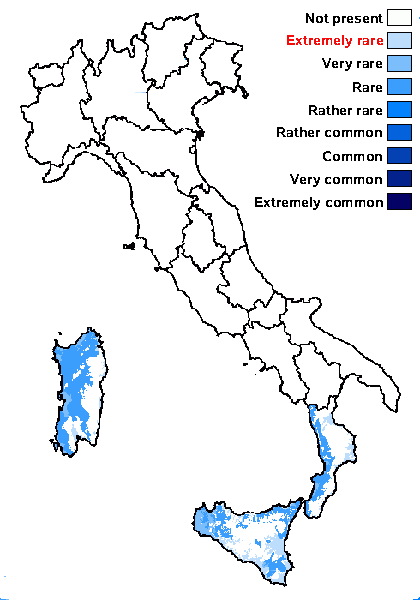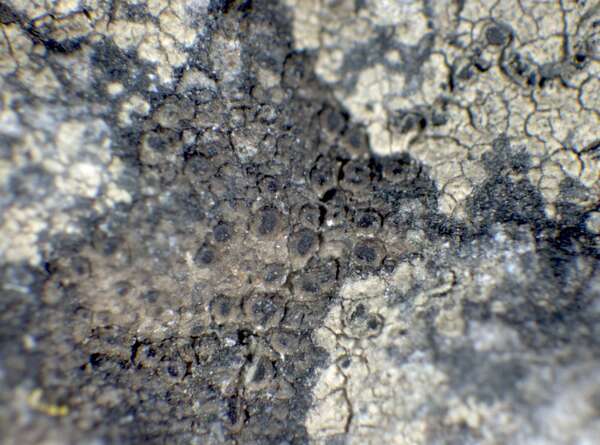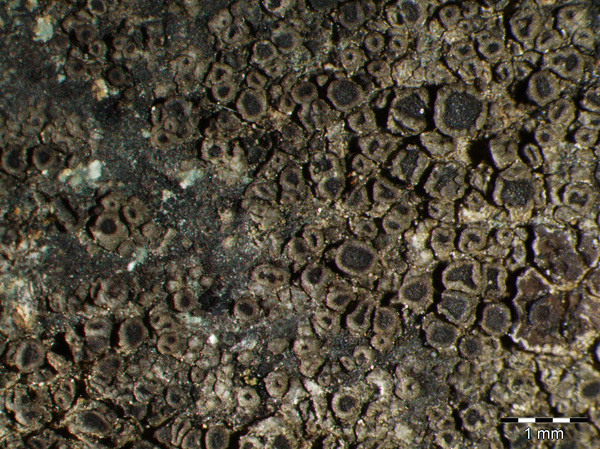Rinodina sicula H. Mayrhofer & Poelt
Bibl. Lichenol., 12: 143, 1979.
Synonyms: Rinodina orculariopsis H. Mayrhofer
Distribution: C - Sar (Mayrhofer & Sheard 2007). S - Cal (Mayrhofer & Sheard 2007), Si (Giralt & Llimona 1997).
Description: Thallus crustose, thinly episubstratic, rimose-areolate to areolate, grey-white to dark grey, often with a pale ochraceous tinge, mostly delimited by a black prothalline line. Apothecia lecanorine, abundant, adnate to sessile, up to 0.6 mm across, with a dark brown to black, flat to slightly convex disc, and an entire, persistent or rarely finally excluded thalline margin. Epithecium pale reddish brown, with an epipsamma of very small crystals; hymenium colourless, 80-100 μm high; paraphyses slender, 1-1.5 μm thick at mid-level, the apical cells only slightly swollen, 2-3 μm wide; hypothecium colourless, up to 100 μm high. Asci 8-spored, clavate, the K/I+ blue tholus penetrated by a faintly amyloid apical cushion with parallel or diverging flanks, the wall K/I-, surrounded by a K/I+ blue outer layer, Lecanora-type. Ascospores 1-septate, brown, ellipsoid, (14-)16-19(-21) x (7.5-)8-10(-11) μm, Physconia-type, with a well-developed torus and a finely warted wall, the ontogeny of type A (apical wall thickening after septum formation). Photobiont chlorococcoid. Spot tests: thallus K-, C+ pink, KC+ pink, P- (reactions best visible on a thick section under the microscope). Chemistry: gyrophoric, lecanoric, orsellinic acids and sometimes traces of zeorin.Note: a Mediterranean to subatlantic early coloniser of compact siliceous rocks, forming inconspicuous patches amongst other crustose lichens; certainly overlooked, and more widespread, especially in Tyrrhenian Italy, but generally rare. Earlier records from Tuscany and Sardinia (see Nimis 1993: 637) refer to saxicolous forms of R. archaea (Mayrhofer & Sheard 2007). See also Giralt & Llimona (1997).
Growth form: Crustose
Substrata: rocks
Photobiont: green algae other than Trentepohlia
Reproductive strategy: mainly sexual
Most common in areas with a humid-warm climate (e.g. most of Tyrrenian Italy)
Pioneer species
Commonnes-rarity: (info)
Alpine belt: absent
Subalpine belt: absent
Oromediterranean belt: absent
Montane belt: absent
Submediterranean belt: absent
Padanian area: absent
Humid submediterranean belt: rare
Humid mediterranean belt: very rare
Dry mediterranean belt: extremely rare

Predictive model
Herbarium samples
Growth form: Crustose
Substrata: rocks
Photobiont: green algae other than Trentepohlia
Reproductive strategy: mainly sexual
Most common in areas with a humid-warm climate (e.g. most of Tyrrenian Italy)
Pioneer species
Commonnes-rarity: (info)
Alpine belt: absent
Subalpine belt: absent
Oromediterranean belt: absent
Montane belt: absent
Submediterranean belt: absent
Padanian area: absent
Humid submediterranean belt: rare
Humid mediterranean belt: very rare
Dry mediterranean belt: extremely rare

Predictive model
| Herbarium samples |
 Index Fungorum
Index Fungorum
 GBIF
GBIF






